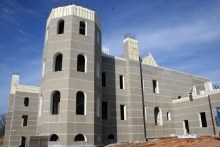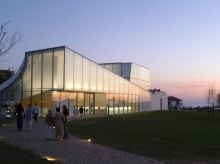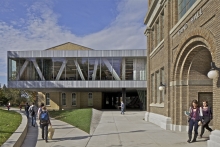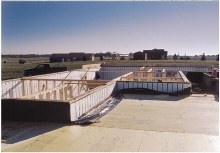- Error
{Re}habitat
Learn how adaptive reuse and upcycling can add hip design to your home, apartment, or yard with the Go Green channel's {Re}habitat series. Follow host Rachael Ranney as she shows you how to repurpose salvaged and found materials, adding fun and function to your space without breaking your budget.

Just a little time spent cleaning those oft-forgotten corners can really make a difference in a room’s appearance. Home improvement writer Jakob Barry shares his tips for making your bathroom gleam, with spring cleaning ideas that are quick and sustainable.
Even when bathrooms are cleaned regularly, they seem to lose their shine in areas that aren’t part of the standard upkeep. For example, you may scrub the toilet and the sink and wash the floor once a week, but what about spots that are a little more out of the way, like shower walls or the bathroom ceiling?
In order for the construction industry to achieve real gains in productivity, new work habits and workflows must be adopted. Fortunately, new tools and technologies can help with this process.
Each day, the members of the team talk with one another to verify tasks for the day. Each week, the superintendent holds foreman’s meetings to gather and disseminate information to the field. Each month, the general contractor meets with the subcontractors and suppliers to verify approval and release of materials. A strong and productive project depends on this type of structure and diligent methodology.
By performing a few simple maintenance tasks, you can keep your refrigerator functioning efficiently throughout its expected lifespan – and maybe even longer.
According to the U.S. Department of Housing and Urban Development’s (HUD) 2009 American Housing Survey (AHS), most homes today have some type of refrigerator. These are available in a variety of sizes, styles, and types, big enough for a family of six or small enough for a single person. Whatever type you may have, one thing is certain: your must maintain your refrigerator. According to the Study of Life Expectancy of Home Components, prepared in 2007 by the National Association of Home Builders (NAHB), the average life expectancy of a standard refrigerator is 13 years. Keep it clean, perform simple maintenance tasks, and you’ll help your refrigerator to operate longer than expected.
Despite technological advances in weather forecasting, natural disasters are often unpredictable. Even when we do know a geological or meteorological disturbance is on its way, very often little can be done to protect existing homes from destruction, so TF Forming Systems is building in that protection from the ground up.
TF Forming Systems owner Steven Huff is in the process of building a large residential structure that will be able to withstand the toughest natural disasters, all while reducing dependence on oil, gas, and coal. TF Forming Systems manufactures and distributes a variety of insulated concrete forms (ICF). The Pensmore Chateau, a 72,000 sq. ft. structure located in the Ozark Mountains of Missouri, is said to be able to withstand F5 tornadoes, in addition to earthquakes, hurricanes, floods, fire, and insect damage. The chateau is located between Springfield and Branson, Mo., near the town of Joplin, which was devastated by F4 and F5 tornadoes in 2011.
Steven Holl Architects' design for a museum near the oceanfront in France is dedicated to the sport of surfing but also calls attention to issues affecting marine ecology.
Since opening in June of 2011, the Cité de l'Océan et du Surf Museum is quickly becoming an iconic tourist destination in Biarritz, France, due to its highly conceptual yet minimalist architecture, its integration with the coastal landscape, and its high-tech exhibits celebrating the leisure, science, and ecology of the ocean.
Welcome to the On Site channel’s Construction Administration Column. This column covers the question of adequate supervision for subcontractors on the job site. Here David A. Todd, P.E., CPESC, gives his opinion.
Columnist David A. Todd, P.E., CPESC, has 37 years of experience in the architecture, engineering, and construction (AEC) industry and has performed much construction administration during that time. He will answer questions from our readers or from his own practice and will provide answers based on his understanding of the construction process and administration of the construction contract. The focus will be on the customary duties of the owner, contractor, and design professional as typically described in the contract documents.
A new academic facility by OMA supports Cornell University's College of Architecture, Art, and Planning (AAP) while bridging several historic campus buildings.
As if designing space for an architecture school weren’t a complicated enough feat, try maneuvering around four historic buildings. OMA’s New York office designed an extension to Cornell University’s College of Architecture, Art, and Planning in Ithaca, New York, which officially opened last October. The modern yet reverent structure consolidates these previously separated programs and promotes interdisciplinary interaction within its open and flexible studios, critique spaces, plaza, and auditorium.
Slabs for Colder Climates, Part 1: The How and Why of Frost-Protected Shallow Foundations
Written by Fernando Pages Ruiz Tue Apr 10 2012As energy savings and the conservation of resources increasingly drive decision-making for homebuilders, frost-protected shallow footings offer a good method for constructing slab-on-grade foundations.
As a builder constructing townhouses, commercial buildings, and the occasional slab-on-grade (SOG) house in frigid Nebraska, I always thought it silly to dig footings half as deep as a full basement when the point of SOG construction was to spend less on foundations. A basement seemed the better value, to me, given that only token cost savings came with a slab ... until one year, while attending the National Association of Home Builders (NAHB) International Builders' Show, I heard a lecture on a new (at least for me) approach to constructing slabs in northern climates that did not require footings to extend below the frost line. I immediately perked up and listened closely; it sounded like a good cost-saving measure.







